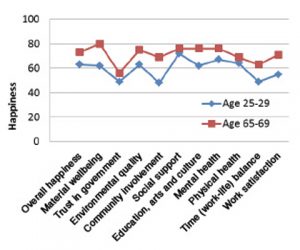I have spent the last four years immersing myself in the subject of happiness. What makes us happy? Who is happy? What matters more, attitudes or life conditions? Can national policies make us happier? For some, happiness, they declare, is a personal matter, unmeasurable, and too frivolous for the affairs of state. But our country was founded on the idea that happiness matters.
For Thomas Jefferson, setting the stage where the citizens of this country could find and secure their own happiness — the sense not of momentary pleasure, but of a satisfied and virtuous life — was not only a personal goal, but also “the only orthodox purpose of the institution of government.” Yet, in his day, it wasn’t feasible to measure happiness; it was all guesswork. Not so today, when the study of happiness has become a science and we are better able than ever before to understand who is happy, and why.
Seniors and the Happiness Gap
My colleagues from the Happiness Initiative have amassed a great deal of data about American happiness based on nearly 30,000 full responses to a lengthy scientific survey. Metrics like income satisfaction, financial security, physical health, access to educational and cultural opportunities, and healthy environmental factors have all been cited as predictive measures of happiness and general wellbeing. In fact, similar metrics are used by UNICEF and the United Nations in their global studies of happiness. (See endnotes for information on these studies.)
Till recently, happiness scores have tended to form what looked like a smiley-face curve, highest in youth and old age, lowest in middle age, when life’s pressures and demands often overwhelm people. But the Happiness Initiative is finding something different: Right now, the unhappiest Americans are those aged 25–29.
As shown in the graph, in all areas of life, seniors are doing much better. They even feel healthier than their younger counterparts! On a scale of 0–100, these are serious differences between the two age groups, equal to the “happiness gap” between Americans and residents of China or India.
The gap of 10 points in overall happiness between age groups 65–69 and 25–29 is even greater than that between the richest and poorest 10% of Americans, suggesting that money alone can’t buy happiness. This is supported by research on childhood well-being conducted by UNICEF, which showed that “there does not appear to be a strong relationship between per capita GDP and overall child well-being.” (UNICEF, 2013)
Young people in the United States seem unhappy and fearful of the future. They face unparalleled debt driven by the high cost of college, and grim job prospects. They fear they will reach old age penniless and pension-less. By contrast, seniors have the most resources among age groups and are more confident about their social support systems.
Where Happiness Ranks Highest
A relatively secure, confident elder class hasn’t always been the case. In the era before Social Security, defined benefit pensions and Medicare, seniors were among the poorest Americans, dependent for their economic security on the benevolence of families. We didn’t measure happiness then, but have reason to believe they would have been far less satisfied with their lot.
Now it’s the very young of this country who fare poorly. Indeed, the UNICEF study ranked the U.S. 26th of 29 nations studied when considering six key metrics of child well-being: economic security, health, housing, environment, education and risky behaviors. Our kids did a bit better when asked how satisfied they were with life, ranking 23rd. In not a single category analyzed by UNICEF did U.S. children rank above the bottom third of the 29 wealthiest nations studied.
The top-performing nation was the Netherlands, which ranked number one in three of the six metrics measured by UNICEF and also number one in reported life satisfaction, a stunning performance. Close behind were children in the Nordic countries. These, in slightly different order, are the same nations that the United Nations World Happiness Report (United Nations, 2013) ranks as having the happiest adults. And though there are not enough data to prove that greater childhood well-being results in happier adults, the correlations are strong.
What Sets These Countries Apart?
If, as we’ve seen, money is not the root of happiness, then what is it about these high-ranking countries that serve to foster happiness?
For one thing, they are all countries with strong government programs and social supports for families, including generous paid family leave, sick leave to care for children, and excellent low-cost healthcare and pre-school. Their laws also support parents in many other ways, including greater opportunities for part-time work sufficient to provide a living wage and long vacation breaks providing an escape from the rush of middle-age life demands. By contrast, American vacations are among the shortest in the world, and we are one of only five countries without a law mandating paid vacation time for workers. Long American work hours are stressful; our lowest scores on the Happiness Initiative survey consistently come in the area of Time Balance.
There is considerable evidence that relaxed parents produce happier children. But our children, reared by stressed parents and pushed through over-scheduled, hyper-competitive childhoods, report themselves more anxious and less happy than in other countries.
Happiness as a Learned Skill
Policy changes providing more leisure time, and less frantic work schedules, would clearly be beneficial to American well-being, especially for parents and children. But policy is not enough. People may have adequate leisure, but if they use it mostly to watch television, they may become less happy instead of more so. As Americans, we need to understand and teach happiness skills, something many seniors have learned by the onset of old age and can consciously impart to their children and grandchildren.
Happiness skills are many, but a few examples should give you an idea of what I mean:
Gratitude. Think of Thanksgiving, when instead of being thankful, Americans are stampeding to buy as much stuff as possible. That’s not food for happiness.
Generosity. The new happiness science shows it truly is “better to give than to receive.” (ABC News Report)
Sociability. Nothing is more important for happiness and health than social connection. Yet, we are increasingly isolated: A 2010 Time/AARP study found that chronic loneliness among Americans over 45 increased from 20 to 35 percent of the population in the previous 10 years alone.
Mindfulness. Slow down and smell the roses!
Time in nature. Our children spend only half as much unstructured time outdoors as they did a generation ago (National Wildlife Foundation Report).
Exercise. Kindness. Patience. Skills we are losing rapidly in this always-on, always-faster culture.
Perhaps the most important happiness skill is service to others. Current research shows that those who volunteer are consistently happier than those who do not (Huffington Post). Sadly, despite years of “service learning” and other efforts to promote volunteerism, we aren’t doing very well in that area. Happiness Initiative survey data indicates that only a third of Americans volunteer even a day of their time each year. Young people see volunteer work as one more thing you have to do to build your resume. That makes it a chore instead of a joy.
One thing is clear in happiness research; the quest for stuff does not make us happier. The Black Friday stampedes are wasted effort and counterproductive. As the damage to our environment, health and social connection makes clear, they come at enormous cost to so many other things we hold dear, especially time to truly live.
Seniors are happier because they have learned the value of time, relationships and gratitude. Once retired, they have more time than before. Seniors can pass along to their children the values of family, connection, sharing, kindness, appreciation of simple pleasures, and service. They can also work to change policies to those that support family leave, sick days, shorter working hours and guaranteed vacations — policies that value time instead of stuff, hours instead of dollars.
In 1912, strikers in Lawrence, Massachusetts, carried banners that read, “We Want Bread, and Roses, Too!” As poor as they were, they knew that money (bread) was not enough. They needed time to smell the roses, time for art, love and beauty, time for play, time for each other. It’s a lesson we need to learn all over again. Teach your children well so that they can teach theirs.





Sources
Books By The Author